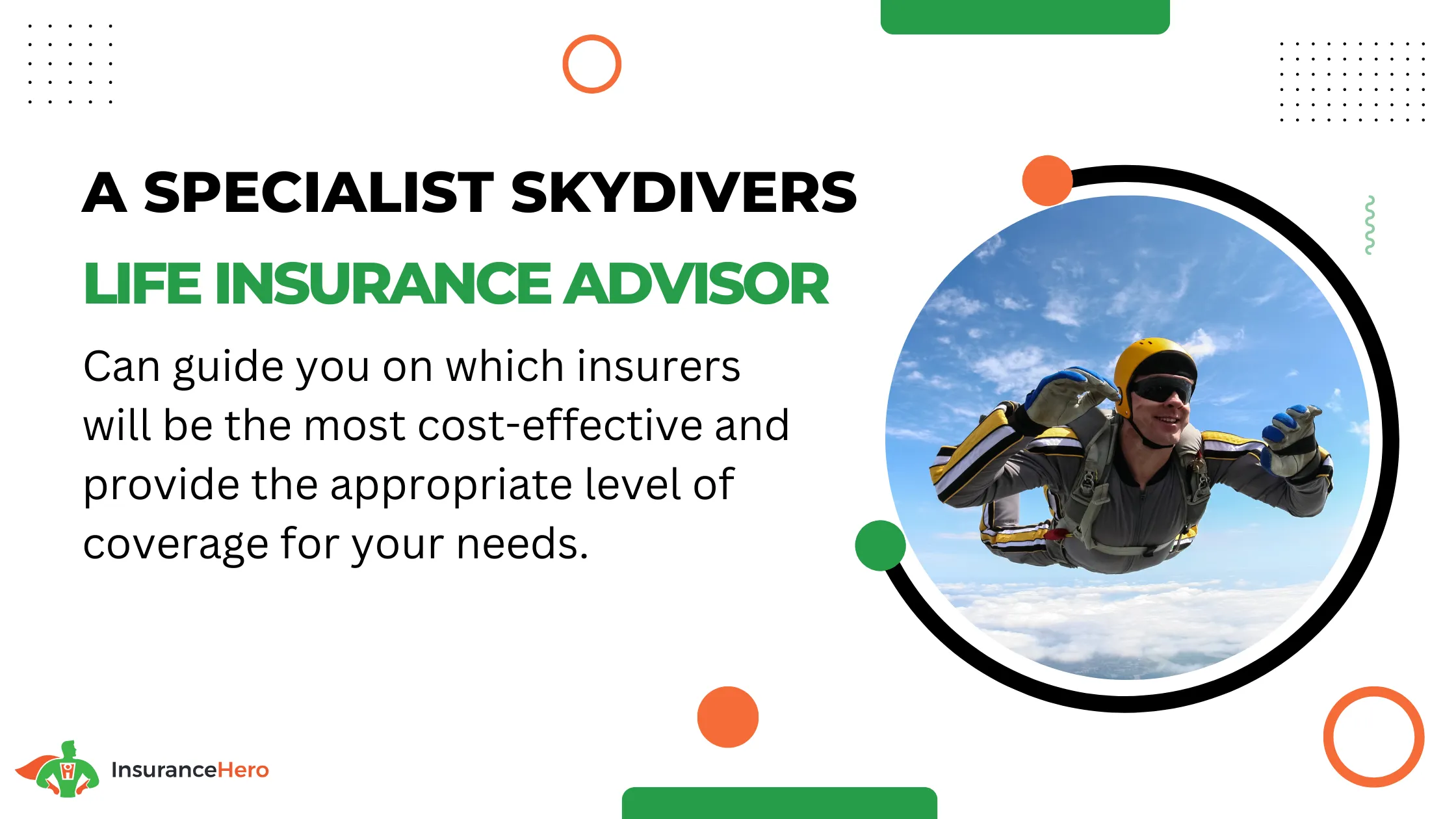Skydiving Life Insurance And Critical Illness Cover

Read our comprehensive guide to life insurance and associated covers. We will explain why getting life cover is essential if you skydive.
The Insurance Hero team comprises specialists dedicated to assisting individuals engaged in extreme sports and high-risk hobbies, particularly those seeking life insurance, critical illness coverage, and income protection for activities such as skydiving.
Through our extensive experience, we have observed that applications for parachuting and skydiving life insurance range from standard rates with no exclusions to moderately increased premiums with some exclusions.
We strive to provide tailored solutions that meet the unique needs of our adventurous clients, ensuring they receive the best possible coverage.
Skydivers Help Protect The Ones You Love – Get A Free Quote Today


How Does Life Insurance Cover Work?
Life insurance works to provide a covered amount for designated beneficiaries should you die while skydiving or in other circumstances throughout the fixed term of a policy.
The cover amount is self-funded through the payment of a pre-determined monthly premium throughout the policy’s life.
How Do Life Insurers View Skydiving, Parachuting Or Base Jumping?
Life Insurance Can Cover The Following Types of Parachuting & Skydiving:
Tandem Skydiving
Jumping attached to an instructor
Ideal for beginners
Minimal training required
Static Line Parachuting
Automatic parachute deployment upon exit
Often used for military training
Suitable for first-time solo jumpers
Accelerated Freefall (AFF)
Rapid progression training method
Freefall from the first jump
Two instructors accompany the student initially
Formation Skydiving (FS)
Also known as Relative Work (RW)
Jumpers create formations in freefall
Requires coordination and practice
Freeflying
Includes vertical and head-down positions
More advanced skydiving discipline
Greater speed and manoeuvrability
Wingsuit Flying
Wearing a specially designed suit to increase surface area
Provides the ability to glide horizontally
Requires advanced skills and experience
BASE Jumping
Jumping from fixed objects (Buildings, Antennas, Spans, Earth)
Extremely high risk
Requires significant experience and skill
Canopy Piloting (Swooping)
High-speed manoeuvres close to the ground
Requires precise control and skill
Often involves navigating a course of gates
Skysurfing
Using a board attached to the feet
Allows for surfing manoeuvres in the air
Advanced discipline requiring high skill
CRW (Canopy Relative Work)
Performing formations with open parachutes
Also known as canopy formations (CF)
Requires coordination with other jumpers
Night Jumps
Skydiving after sunset
Requires additional safety measures and equipment
Offers a unique and thrilling experience
High Altitude Low Opening (HALO)
Jumping from extremely high altitudes
Delayed parachute deployment
Requires special equipment and training
Hop and Pop
Immediate parachute deployment after exit
Typically, from lower altitudes
Often used for canopy training
Indoor Skydiving
Simulating freefall in a vertical wind tunnel
No actual jump involved
It is ideal for training and practice without the risk
The risks in Skydiving can include severe injury or death as a result of rough landings, a hostile environment, or equipment failure.
Underwriters will want to know the extent of your skydiving activities. Insurance premiums can sometimes be loaded, especially if the number of jumps exceeds 50 per year.
A loaded insurance premium for Skydiving uses additional skydives as a basis for calculation.
Assessing Your Skydiving Activities
Insurance Hero wants to include your skydiving activities in your life insurance policy, ensuring that premiums reflect your activities, are not unnecessarily loaded, and are certainly not excluded from the policy.
Insurance Hero, Your Skydiving Insurance Expert
Underwriters trust Insurance Hero due to our rigorous fact-finding questionnaires. We work with you, our clients, to understand the nature of your skydiving activities.
Answering questions honestly helps ensure that the premium correctly reflects the activities undertaken. It will also ensure that there will be no dispute about your skydiving pursuits should you die.
Compare The UK’s Top Insurers & Get Your Free No-Obligation Quote Now.

Fact-finding questions that we ask via a telephone call to ascertain your involvement in the pursuit will include some of the following:
- What type of Skydiving do you participate in?
- Where do you skydive?
- At what altitude do you skydive?
- How many skydives do you make in a year?

Understanding Critical Illness Cover
An associated cover of life insurance is critical illness. Whereas life insurance pays out upon death, critical illness pays out should you survive a recognised disease or medical procedure diagnosis.
Payout typically occurs after ten days of survival from diagnosis. At the onset, a standard list of critical illnesses is generally part of a policy. Additional diseases and medical procedures correlated to your skydiving pursuits can be included initially.
For example, the list of broken or fractured bones from a bad fall or landing is prevalent.
Here is a short list of critical illnesses and medical procedures covered in a standard policy:
- Certain types of cancer
- Alzheimer’s disease or pre-senile dementia
- Coronary artery by-pass grafts
- Creuzfeldt-Jakob disease
- Devic’s disease
- Loss of speech
- Loss of a hand or a foot
- Parkinson’s disease
- Cardiac Arrest
- Stroke
- Severe lung disease
- Heart attack
- Liver disease
- Kidney failure
Critical illness includes three types of additional cover: increasing, decreasing, and level cover.
Increasing critical illness cover
Over the policy term, the payout amount will increase in line with the consumer price index (CPI), an inflation indicator. In years where there is no inflation increase, the payout amount typically remains unchanged.
Decreasing critical illness cover
The payout amount decreases every month during the policy’s fixed term. This could be useful in matching a mortgage’s payment schedule, which reduces over time.
Level critical illness cover
With level critical illness cover, the cover amount remains unchanged throughout the life of the policy.
Contact Insurance Hero today for your critical illness policy needs. Our professional team of brokers will guide you through this type of life cover and get you a quote closely correlated to your needs. Call now on 0203 129 88 66 for a free, no-obligation quote.
Income Protection Cover For Skydivers
Income protection provides a regular salary if you cannot work for a time. A skydiving accident may leave you unable to work and receive a salary from your employer.
Paying a regular premium into a fixed-term income protection plan will cover this eventuality.
The salary amount is confirmed at the outset of the policy. The first salary payment following a claim typically occurs between one month and one year.
Income protection is essential if you have outstanding debt, including but not limited to the following:
- Mortgage
- Personal Loans
- Credit card debt
- Hire purchase agreements
- Equity release
- School fees
Related sports life insurance guides:
Understanding Sailing Life Insurance Cover In 2025
This guide provides an overview of life insurance and associated cover for sailing and yachting. Read on, and we…
Discover Ballooning Life Insurance – Get Peace Of Mind Today
Do you have loved ones? Do you want to protect them when you undertake your ballooning pursuits? This concise ba…
Top-Rated Life Insurance For Motorcycle Riders & Bikers 2025
Motorcycle riding is a favourite pastime for many, but it may also be necessary for their job or their only form of tran…
Extreme Sports Life Insurance Cover Get Quotes Today
This short guide explains why you should take out life insurance. If you have loved ones, read on for how you can enjoy …
Affordable Rugby Players Life Insurance 2025
In this short guide, we explain how we can get both professional and amateur rugby players a competitive and tailored li…
Hang Gliding Paragliding Life Insurance 2025
Do you Hang-Glide or a Paraglider Pilot and Need Life Insurance Cover? This short guide explains why participati…
Motorsports Life Insurance And Critical Illness Cover 2025
Whatever your participation in motorsports, do you want continuous peace of mind? Carry on reading and find out …
Rock Climbing Life Insurance Cover In 2025
This short guide will discuss why you should get rock climbing life insurance cover. We will explain how Insurance Hero …
Life Insurance For Private Pilots 2025
This guide explains how to get a competitive pilots life insurance quote. We have been helping pilots for many years get…
Best Life Insurance For Bodybuilders & Weight Lifters 2025
Are you a professional or recreational bodybuilder? Do you want financial security for your loved ones should something …
Scuba Diving Life Insurance Compare Quotes 2025
Are you worried that your family will suffer if you have an accident or even die while scuba diving? Insurance H…
Cycling Life Insurance For All Cyclists Made Easy
In this guide, we will explain how you can get your cycling activities included as part of your life insurance policy. …
Life Insurance For Horse Riders 2025
Our new guide explains why your horse riding pursuit is an activity to include in your life insurance policy. We…
Does Life Insurance Cover Skiing And Snowboarding?
Life insurance for winter sports, including skiing, snowboarding, and mountaineering, is widely offered by many UK insur…
Canoeing And Kayaking Life Insurance Cover 2025
In this brief guide, we will explain why, as a Kayaker, you should get life insurance cover. We will even share …
Steve Case is a seasoned professional in the UK financial services and insurance industry, with over twenty years of experience. At Insurance Hero, Steve is known for his ability to simplify complex insurance topics, making them accessible to a broad audience. His focus on clear, practical advice and customer service excellence has established him as a respected leader in the field.


